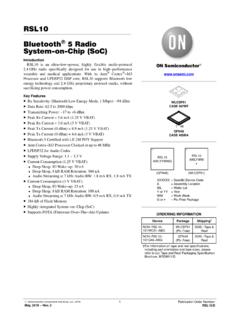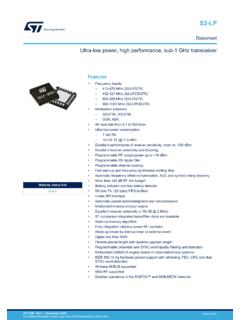Transcription of 300MHz to 450MHz, 3.3V ASK/OOK Receiver with RSSI and …
1 MICRF220. 300 MHz to 450 MHz, ASK/OOK Receiver with rssi and Squelch General Description Features The MICRF220 is a 300 MHz to 450 MHz super- 110dBm sensitivity at 1kbps with BER. heterodyne, image-reject, RF Receiver with automatic Supports bit rates up to 20kbps at gain control, ASK/OOK demodulator, analog rssi . 25dB image-reject mixer output, and integrated squelch features. It only requires a crystal and a minimum number of external components No IF filter required to implement. The MICRF220 is ideal for low-cost, low- 60dB analog rssi output range power, RKE, TPMS, and remote actuation applications. to supply voltage range The MICRF220 achieves 110dBm sensitivity at a bit supply current at 315 MHz rate of 1kbps with BER. Four demodulator filter supply current at 434 MHz bandwidths are selectable in binary steps from 1625Hz to 13kHz at , allowing the device to support A supply current in shutdown mode bit rates up to 20kbps.
2 The device operates from a Data output squelch until valid bits detected supply voltage of to , and typically consumes 16-pin QSOP package ( x ). of supply current at 315 MHz and at 40 C to +105 C temperature range A shutdown mode reduces supply current to 3kV HBM ESD Rating A typical. The squelch feature decreases the activity on the data output pin until valid bits are detected while maintaining overall Receiver sensitivity. Datasheets and support documentation can be found on Micrel's website at: Typical Application , 1kbps Operation Micrel Inc. 2180 Fortune Drive San Jose, CA 95131 USA tel +1 (408) 944-0800 fax + 1 (408) 474-1000 August 19, 2015 Revision or (408) 944-0800. Micrel, Inc. MICRF220. Ordering Information Part Number Temperature Range Package MICRF220 AYQS 40 C to +105 C 16-Pin QSOP. Pin Configuration MICRF220 AYQS. Pin Description Pin Pin Pin Function Number Name Reference resonator connection to the Pierce oscillator.
3 May also be driven by external reference signal of 1 RO1. 200mVp-p to p-p amplitude maximum. Internal capacitance of 7pF to GND during normal operation. 2 GNDRF Ground connection for ANT RF input. Connect to PCB ground plane. Antenna Input: RF Signal Input from Antenna. Internally AC coupled. It is recommended to use a matching 3 ANT. network with an inductor-to-RF ground to improve ESD protection. 4 GNDRF Ground connection for ANT RF input. Connect to PCB ground plane. Positive supply connection for all chip functions. Bypass with F capacitor located as close to the VDD pin 5 VDD. as possible. Squelch Control Logic-Level Input. An internal pull-up (5 A typical) pulls the logic-input HIGH when the device 6 SQ is enabled. A logic LOW on SQ squelches, or reduces, the random activity on DO pin when there is no RF. input signal. Demodulator Filter Bandwidth Select Logic-Level Input.
4 This pin has an internal pull-up (3 A typical) when the 7 SEL0. chip is on. Use in conjunction with SEL1 to control demodulation bandwidth. Shutdown Control Logic-Level Input. A logic-level LOW enables the device. A logic-level HIGH places the 8 SHDN. device in low-power shutdown mode. An internal pull-up (5 A typical) pulls the logic input HIGH. 9 GND Ground connection for all chip functions except for RF input. Connect to PCB ground plane. Data Output. Demodulated data output. A current limited CMOS output during normal operation, 25k pull- 10 DO. down is present when device is in shutdown. Demodulator Filter Bandwidth Select Logic-Level Input. This pin has an internal pull-up (3 A typical) when the 11 SEL1. chip is on. Use in conjunction with SEL0 to Demodulation bandwidth. Demodulation Threshold Voltage Integration Capacitor. Connect a F capacitor from CTH pin-to-GND to 12 CTH.
5 Provide a stable slicing threshold. AGC Filter Capacitor. Connect a capacitor from this pin to GND. Refer to the AGC Loop and CAGC section for 13 CAGC. information on the capacitor value. Received Signal Strength Indicator. The voltage on this pin is an inversed amplified version of the voltage on 14 rssi . CAGC. Output is from a switched capacitor integrating op amp with 250 typical output impedance. 15 NC No Connect. Leave this pin floating. Reference resonator connection to the Pierce oscillator. Internal capacitance of 7pF to GND during normal 16 RO2. operation. August 19, 2015 2 Revision Micrel, Inc. MICRF220. Absolute Maximum Ratings(1) Operating Ratings(2). Supply Voltage (VDD) .. +5V Supply Voltage (VDD) .. + to + ANT, SQ, SEL0, SEL1, Ambient Temperature (TA).. 40 C to +105 C. SHDN DC Voltage.. to VDD + ANT, SQ, SEL0, SEL1, Junction Temperature .. +150 C SHDN DC Voltage.
6 To VDD + Lead Temperature (soldering, 10sec.) .. +300 C Maximum Input RF Power .. 0 dBm Storage Temperature .. 65 C to +150 C Receive Modulation Duty Cycle .. 20~80%. Maximum Receiver Input Power .. +10dBm Frequency Range .. 300 MHz to 450 MHz (3). ESD Rating .. 3kV HBM. Electrical Characteristics VDD = , VSHDN = GND = 0V, SQ = open, CCAGC = F, CCTH = F, unless otherwise noted. Bold values indicate 40 C TA 105 C. Bit rate refers to the encoded bit rate throughout this datasheet (see Note 4). Parameter Condition Min. Typ. Max. Units Continuous Operation, fRF = 315 MHz Operating Supply Current mA. Continuous Operation, fRF = Shutdown Current VSHDN = VDD A. Receiver , VSEL1 = VSEL0 = 0V, BER = 1% , VSEL1 = VSEL0 = 0V, 110. BER = Conducted Receiver 315 MHz, VSEL1 = 0V, VSEL0 = , dBm Sensitivity@1kbps (Note 5) BER = 1%. 315 MHz, VSEL1 = 0V, VSEL0 = , 110. BER = Image Rejection fIMAGE = fRF 2fIF 25 dB.
7 FRF = 315 MHz IF Center Frequency (fIF) MHz fRF = fRF = 315 MHz 235. 3dB IF Bandwidth kHz fRF = 330. 40dBm RF input level CAGC Voltage Range V. 100dBm RF input level Reference Oscillator Reference Oscillator fRF = 315 MHz MHz Frequency fRF = MHz Reference Buffer Input RO1 when driven externally k . Impedance Reference Oscillator Bias RO2 V. Voltage Reference Oscillator Input External input, AC couple to RO1 VP-P. Range Reference Oscillator Source VRO1 = 0V 300 A. Current August 19, 2015 3 Revision Micrel, Inc. MICRF220. Electrical Characteristics (Continued). Parameter Condition Min. Typ. Max. Units Demodulator CTH Source Impedance, fREF = 165. k . Note 6 fREF = 120. CTH Leakage Current In TA = +25 C 1. nA. CTH Hold Mode TA = +105 C 10. Digital / Control Functions As output source @ VDD 300. DO Pin Output Current A. As output sink @ VDD 680. Output Rise Time 15pF load on DO pin, transition time 600.
8 Ns Output Fall Time between and 200. Input High Voltage SHDN, SEL0, SEL1, SQ V. Input Low Voltage SHDN, SEL0, SEL1, SQ V. Output Voltage High DO V. Output Voltage Low DO V. rssi . rssi DC Output Voltage 110dBm RF input level V. Range 50dBm RF input level rssi Output Current 5k load to GND, 50dBm RF input level 400 A. rssi Output Impedance 250 . VSEL0 = VSEL1 = 0V, RF input power stepped rssi Response Time 10 ms from no input to 50dBm Notes: 1. Exceeding the absolute maximum rating may damage the device. 2. The device is not guaranteed to function outside of its operating rating. 3. Device is ESD sensitive. Use appropriate ESD precautions. Exceeding the absolute maximum rating may damage the device. 4. Encoded bit rate is 1/(shortest pulse duration) that appears at MICRF220 DO pin. 5. In an ON/OFF keyed (OOK) signal, the signal level goes between a mark level (when the RF signal is ON) and a space level (when the RF.)
9 Signal is OFF). Sensitivity is defined as the input signal level when ON necessary to achieve a specified BER (bit error rate). BER measured with the built-in BERT function in Agilent E4432B using the PN9 sequence. Sensitivity measurement values are obtained using an input matching network corresponding to 315 MHz or 6. CTH source impedance is inversely proportional to the reference frequency. In production testing, the typical source impedance value is verified with 12 MHz reference frequency. August 19, 2015 4 Revision Micrel, Inc. MICRF220. Typical Characteristics VDD = , TA = +25 C, BER measured with PN9 sequence, unless otherwise noted. Current vs. Receiver Current vs. Supply Voltage Current vs. Supply Voltage Frequency fRF = fRF = 315 MHz +105 C. +105 C. Current (mA). Current (mA). Current (mA). +25 C +25 C. -40 C. -40 C. 300 325 350 375 400 425 450 Receiver Frequency (MHz) Supply Voltage (V) Supply Voltage (V).
10 CAGC Voltage vs. Input rssi vs. Input Power BER vs. Input Power Power VSEL1 = VSEL0 = 0V. 10. rssi Voltage (V). -40 C CAGC Voltage (V). +105 C. BER (%). +25 C 315 MHz 1 `. -40 C +105 C. +25 C. PN9 sequence at 1kbps -125 -100 -75 -50 -25 0 -125 -100 -75 -50 -25 0 -116 -115 -114 -113 -112 -111 -110. Input Power (dBm) Input Power (dBm) Input Power (dBm). Sensitivity at 1% BER Sensitivity at 1% BER Sensitivity at 1% BER. VSEL1 = VSEL0 = 0V VSEL1 = 0V, VSEL0 = VSEL1 = , VSEL0 = 0V. -98 -100 -98. -100. -102 -100. -102. Sensitivity (dBm). Sensitivity (dBm). Sensitivity (dBm). -104 -102. -104. -106 315 MHz -106 315 MHz -104 315 MHz -108 -108 -106. -110 -110 -108. -112. -112 -110. -114. -116 -114 -112. 0 2 4 6 8 10 12 0 3 6 9 12 15 18 21 0 10 20 30 40. Bit Rate (kbps) Bit Rate (kbps) Bit Rate (kbps). August 19, 2015 5 Revision Micrel, Inc. MICRF220. Typical Characteristics (Continued).
















